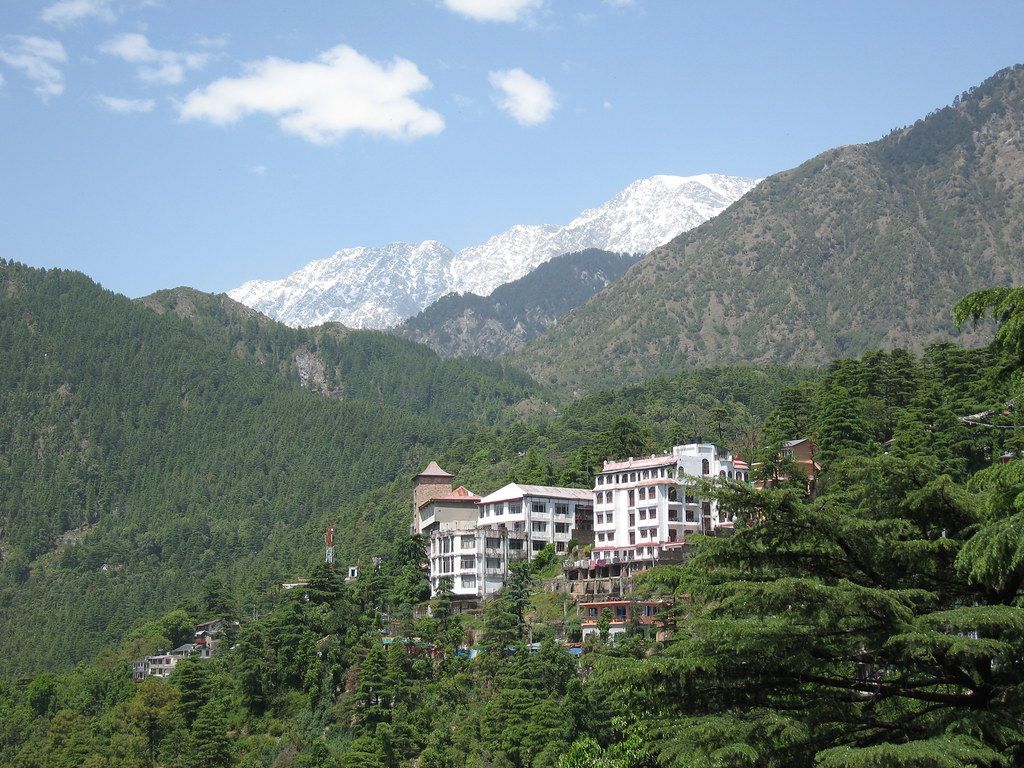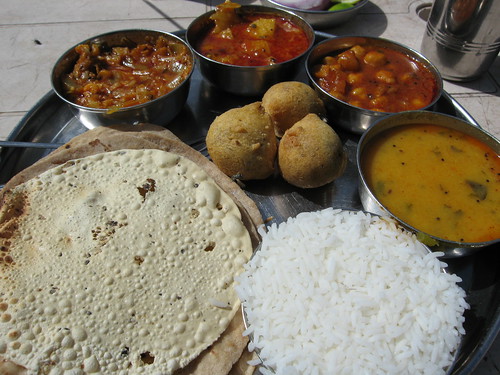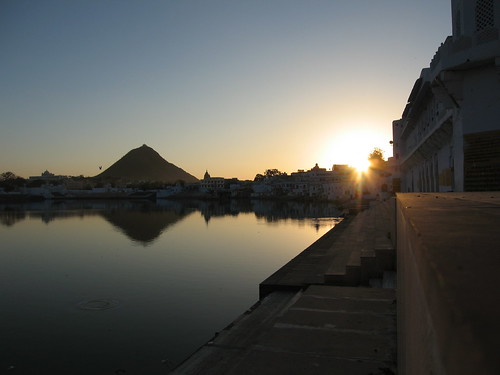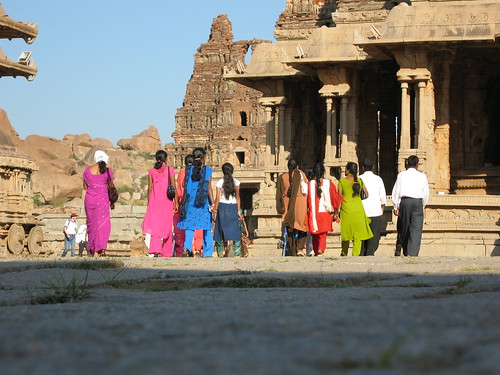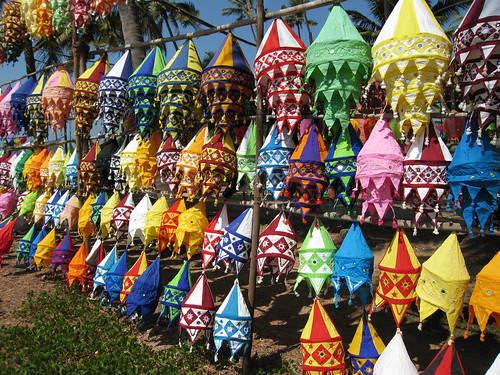Indian Observations
Observations on India.
Over the past five months we've come across some interesting idiosyncrasies that make India just that little bit unique, here are some of them....
Cricket -
Indians are absolutely fanatical about the sport. Even the poorest most remote villages have a boundary marked out and a makeshift wicket in place. Cricket pitches are snookered into the most impossible of spaces, an uphill street, by a river bank, on a rooftop. School yards typically have multiple games on the go. And that's just the children! There are three dedicated national TV channels showing around the clock highlights of world cricket. Every business has a television or radio in the corner with the cricket on. For the male adults it's the main source of conversation. Once the Australian passport comes out it's predictably a "Ricky Ponting this...", "Brett Lee that..." twenty minute debate. The cricket players themselves are national superstars enjoying lucrative sponsorship deals. During our time in India the controversy over Symonds and racial abuse was brewing and the Indian media was playing into the hands of the emotional fanatics. The normal mudslinging followed by players reactions was meticulously over-reported. Speaking from my neutral standing point - it was amusing to watch an interview with an Australian player, one sentence would typically be taken out of context of the whole interview and it would suddenly be making the "breaking news" ticker across the Indian news channels. This happened so regularly that it was clear the whole exercise was to hype up the crowds and create heightened tension and excitement rather than animosity.
The MRP (Maximum Retail Price)
It's a godsend to travellers - and an idea that should be adapted elsewhere in this world. The MRP or Maximum Retail Price is the highest price, inclusive of taxes, that can be charged for any item. Everything in India from bottled water, soap, televisions, kitchen tiles and cars all have an MRP clearly marked on it as part of the packaging. The MRP is designed to give the shopkeeper a healthy profit and to regulate pricing. In theory everyone benefits - in practise there are opportunists who'll blatantly and illegally overcharge travellers. If you're heading to India the MRP is your friend.
The Indian Head Wiggle -
The infamous Indian head wiggle, it's a bizarre Indian trait that takes alot of getting used to. Does it mean a "yes" or a "no" ... in actual fact it can mean "yes", "no", "maybe" or "I don't know but I'm being friendly" depending on who is answering the question. In short the golden rule is that you can never ever trust a straight answer out of a wiggle. To do this is to assume the answer. Infuriatingly there have been countless times when we've enquired about rooms or asked about buses to a destination only to get a wiggle back. I've often wiggled back at them asking does this mean yes or no ... only to get another wiggle in return. There is a solution though, you simply don't ask a question that has a binary yes or no answer i.e. "Which bus goes to Delhi?" or "How much are your rooms?" this tactic forces the answerer into a worded answer which dispells any ambiguous wiggling.
Once this questioning technique is mastered the battle is half over. Our western nod indicating "no" is very very similar to an Indian wiggle and is as such determined as one by Indians. We've been full to the brim in restaurants and the waiter has come over to dole out another load of rice and curry, naturally our automatic response has been to very vigorously nod to the negative. This nod "No" is interpreted as a "bring it on" and the food starts appearing on the plate. There is only one way we've found to stem the tide is to put our hand over the plate physically creating a barrier and say "no" resisting any impulsive movement of the head. It's actually very difficult to do.
Queueing -
The British left behind the notion of an orderly queue and for the most part people know the rules but don't really follow them. When someone comes to join a queue they'll regularly slot themselves into a space in the queue rather than join the back. It's almost as if the space is a delimiter between those who are in the queue and those who are considering joining the queue but haven't yet committed - hence the space. If a "slotter" into the queue is challenged they'll adamantly defend their positioning truly believing they are next in line. Once you make it to top of any queue it's a free for all as there is always someone with a special need that merits a complete queue skip more often than not it's opportunism.
When it comes to ladies it's a different story altogether, by right a lady can go straight the top of any queue and be served next. This leads to the conundrum of two queues at the one counter, one of ladies and one men. In this case the rule is that the queues are serviced in a round robin fashion. In busy places like train stations there is the concept of an exclusive "ladies queue". Skipping of any nature in this queue is simply not an option. It's a civilised yet cutthroat military style line where everyone knows precisely who is next. In an effort to keep things tight and eliminate any potential gaps the ladies bury their knuckles in the small of the back of the person in front and lean in. The result is an uncomfortable, painful pressure to lean forward and psychological push towards the front. As the ladies queue is generally shorter than any of the general queues most of the women have been solicited to buy tickets by men. At Varanasi train station there were so many men trying to skip to the top of the ladies queue that a policeman had to come along with a big stick to disperse the menfolk and patrol the ladies area.
City Eating -
In big Indian cities supporting millions of people you would expect numerous cheap and cheerful restaurants to service the masses. In reality in many of the cities there is a surprising dearth of budget eating places. Restaurants tend to be of the more expensive airconditioned, white table cloth variety. So the question arises - where does everyone eat? The answer is at the street stalls. City workers seem to snack continuously during the day. There are different snacks depending on the time of day and there are no queueing rules when it comes to getting close to a busy street vendor. Small carts can be found in every city whipping up chappatis, dhals, samosas, deserts and a host of different snacks for thousands of people. Every corner has it's stall brewing up chai sold in disposable terracotta cups, one user only, then it's smashed on the ground.
Alcohol -
As a Hindu nation alcohol is not consumed by the vast majority of Indians. In emerging well to do cities like Mumbai and Bangalore there are lots of fancy bars and nightclubs. These places are of the exception and accessible only to an elite few. For the ordinary citizen alcohol is consumed quickly outside the ubiquitous 'English Wine Shop'. The Wine Shops are small shops hidden away behind security grills. Huge measures of cheap brandy or whiskey are served out through a hatch in plastic cups. There is no social element to consumption, groups of men gather, fire back some seriously strong shots and stagger home drunk. There is no middle ground, it's all or nothing. The alcohol itself is priced on volume rather than on strength. So it's cheaper to buy a half bottle of whiskey or brandy than a beer - this encourages consumption of more potent liquors. Without any social aspect to consumption this seems set to continue as a growing concern.
The advertising of alcohol is another bizarre aspect of India. India makes it's own brands of beers and spirits, all of which are heavily advertised on TV but under the guise of other products. Young models will dance around drinkless having a good time and then a ridiculous voiceover will come on saying Royal Challenge Golf Accessories (Whiskey) or White Mischief Holidays (Vodka) or Fosters Packaged Drinking Water (Beer). Not sure who is kidding who.
Women
An odd thing we've noticed as backpackers in India is that our contact with Indian females has been very limited. We mostly deal with people in the service industries and 99% of the waiters, hotel staff, cleaners, shop keepers have been men. We have rarely come across a women in any of these jobs and has a result have had very little normal interaction with Indian women to the extent that when we have seen a women in a shop we've actually gone out of our way to buy from her. When we stayed with Krishna's family in Chennai we had a great opportunity to ask his mother lots of questions and meet with his female family and friends and get a balanced view of life in India.
The definite observation on Indian women is that they are the most colourfully dressed women in the world. In the dirtiest dustiest villages worlds away from automatic washing machines the women sport bright clean saris. I think elsewhere in the world we'd definitely take the easy way out and opt for brown smocks that don't show the dirt!
Boarding Trains and Buses
Not a big observation, more one that has amused us over the months. In any village, city, town for extra thrill the preferred method of boarding a train or bus is whilst the vehicle is in motion. Men will always wait until the last moment to run alongside the bus and board in a dramatic fashion. Hanging on for dear life is not a thrill we've spend too much time tapping in to.
India is a fascinating country to have spent time in. Its diversity of people, landscape and just about everything else you could imagine, keeps you interested, challenged and feeling the life spirit of its people. Don't let anything put you off tasting India for yourself, the only way you will generate your own feelings is to give it a go yourself. See you there.
Read Full Post...
Over the past five months we've come across some interesting idiosyncrasies that make India just that little bit unique, here are some of them....
Cricket -
Indians are absolutely fanatical about the sport. Even the poorest most remote villages have a boundary marked out and a makeshift wicket in place. Cricket pitches are snookered into the most impossible of spaces, an uphill street, by a river bank, on a rooftop. School yards typically have multiple games on the go. And that's just the children! There are three dedicated national TV channels showing around the clock highlights of world cricket. Every business has a television or radio in the corner with the cricket on. For the male adults it's the main source of conversation. Once the Australian passport comes out it's predictably a "Ricky Ponting this...", "Brett Lee that..." twenty minute debate. The cricket players themselves are national superstars enjoying lucrative sponsorship deals. During our time in India the controversy over Symonds and racial abuse was brewing and the Indian media was playing into the hands of the emotional fanatics. The normal mudslinging followed by players reactions was meticulously over-reported. Speaking from my neutral standing point - it was amusing to watch an interview with an Australian player, one sentence would typically be taken out of context of the whole interview and it would suddenly be making the "breaking news" ticker across the Indian news channels. This happened so regularly that it was clear the whole exercise was to hype up the crowds and create heightened tension and excitement rather than animosity.
The MRP (Maximum Retail Price)
It's a godsend to travellers - and an idea that should be adapted elsewhere in this world. The MRP or Maximum Retail Price is the highest price, inclusive of taxes, that can be charged for any item. Everything in India from bottled water, soap, televisions, kitchen tiles and cars all have an MRP clearly marked on it as part of the packaging. The MRP is designed to give the shopkeeper a healthy profit and to regulate pricing. In theory everyone benefits - in practise there are opportunists who'll blatantly and illegally overcharge travellers. If you're heading to India the MRP is your friend.
The Indian Head Wiggle -
The infamous Indian head wiggle, it's a bizarre Indian trait that takes alot of getting used to. Does it mean a "yes" or a "no" ... in actual fact it can mean "yes", "no", "maybe" or "I don't know but I'm being friendly" depending on who is answering the question. In short the golden rule is that you can never ever trust a straight answer out of a wiggle. To do this is to assume the answer. Infuriatingly there have been countless times when we've enquired about rooms or asked about buses to a destination only to get a wiggle back. I've often wiggled back at them asking does this
Once this questioning technique is mastered the battle is half over. Our western nod indicating "no" is very very similar to an Indian wiggle and is as such determined as one by Indians. We've been full to the brim in restaurants and the waiter has come over to dole out another load of rice and curry, naturally our automatic response has been to very vigorously nod to the negative. This nod "No" is interpreted as a "bring it on" and the food starts appearing on the plate. There is only one way we've found to stem the tide is to put our hand over the plate physically creating a barrier and say "no" resisting any impulsive movement of the head. It's actually very difficult to do.
Queueing -
The British left behind the notion of an orderly queue and for the most part people know the rules but don't really follow them. When someone comes to join a queue they'll regularly slot themselves into a space in the queue rather than join the back. It's almost as if the space is a delimiter between those who are in the queue and those who are considering joining the queue but haven't yet committed - hence the space. If a "slotter" into the queue is challenged they'll adamantly defend their positioning truly believing they are next in line. Once you make it to top of any queue it's a free for all as there is always someone with a special need that merits a complete queue skip more often than not it's opportunism.
When it comes to ladies it's a different story altogether, by right a lady can go straight the top of any queue and be served next. This leads to the conundrum of two queues at the one counter, one of ladies and one men. In this case the rule is that the queues are serviced in a round robin fashion. In busy places like train stations there is the concept of an exclusive "ladies queue". Skipping of any nature in this queue is simply not an option. It's a civilised yet cutthroat military style line where everyone knows precisely who is next. In an effort to keep things tight and eliminate any potential gaps the ladies bury their knuckles in the small of the back of the person in front and lean in. The result is an uncomfortable, painful pressure to lean forward and psychological push towards the front. As the ladies queue is generally shorter than any of the general queues most of the women have been solicited to buy tickets by men. At Varanasi train station there were so many men trying to skip to the top of the ladies queue that a policeman had to come along with a big stick to disperse the menfolk and patrol the ladies area.
City Eating -
In big Indian cities supporting millions of people you would expect numerous cheap and cheerful restaurants to service the masses. In reality in many of the cities there is a surprising dearth of budget eating places. Restaurants tend to be of the more expensive airconditioned, white table cloth variety. So the question arises - where does everyone eat? The answer is at the street stalls. City workers seem to snack continuously during the day. There are different snacks depending on the time of day and there are no queueing rules when it comes to getting close to a busy street vendor. Small carts can be found in every city whipping up chappatis, dhals, samosas, deserts and a host of different snacks for thousands of people. Every corner has it's stall brewing up chai sold in disposable terracotta cups, one user only, then it's smashed on the ground.
Alcohol -
As a Hindu nation alcohol is not consumed by the vast majority of Indians. In emerging well to do cities like Mumbai and Bangalore there are lots of fancy bars and nightclubs. These places are of the exception and accessible only to an elite few. For the ordinary citizen alcohol is consumed quickly outside the ubiquitous 'English Wine Shop'. The Wine Shops are small shops hidden away behind security grills. Huge measures of cheap brandy or whiskey are served out through a hatch in plastic cups. There is no social element to consumption, groups of men gather, fire back some seriously strong shots and stagger home drunk. There is no middle ground, it's all or nothing. The alcohol itself is priced on volume rather than on strength. So it's cheaper to buy a half bottle of whiskey or brandy than a beer - this encourages consumption of more potent liquors. Without any social aspect to consumption this seems set to continue as a growing concern.
The advertising of alcohol is another bizarre aspect of India. India makes it's own brands of beers and spirits, all of which are heavily advertised on TV but under the guise of other products. Young models will dance around drinkless having a good time and then a ridiculous voiceover will come on saying Royal Challenge Golf Accessories (Whiskey) or White Mischief Holidays (Vodka) or Fosters Packaged Drinking Water (Beer). Not sure who is kidding who.
Women
An odd thing we've noticed as backpackers in India is that our contact with Indian females has been very limited. We mostly deal with people in the service industries and 99% of the waiters, hotel staff, cleaners, shop keepers have been men. We have rarely come across a women in any of these jobs and has a result have had very little normal interaction with Indian women to the extent that when we have seen a women in a shop we've actually gone out of our way to buy from her. When we stayed with Krishna's family in Chennai we had a great opportunity to ask his mother lots of questions and meet with his female family and friends and get a balanced view of life in India.
The definite observation on Indian women is that they are the most colourfully dressed women in the world. In the dirtiest dustiest villages worlds away from automatic washing machines the women sport bright clean saris. I think elsewhere in the world we'd definitely take the easy way out and opt for brown smocks that don't show the dirt!
Boarding Trains and Buses
Not a big observation, more one that has amused us over the months. In any village, city, town for extra thrill the preferred method of boarding a train or bus is whilst the vehicle is in motion. Men will always wait until the last moment to run alongside the bus and board in a dramatic fashion. Hanging on for dear life is not a thrill we've spend too much time tapping in to.
India is a fascinating country to have spent time in. Its diversity of people, landscape and just about everything else you could imagine, keeps you interested, challenged and feeling the life spirit of its people. Don't let anything put you off tasting India for yourself, the only way you will generate your own feelings is to give it a go yourself. See you there.





